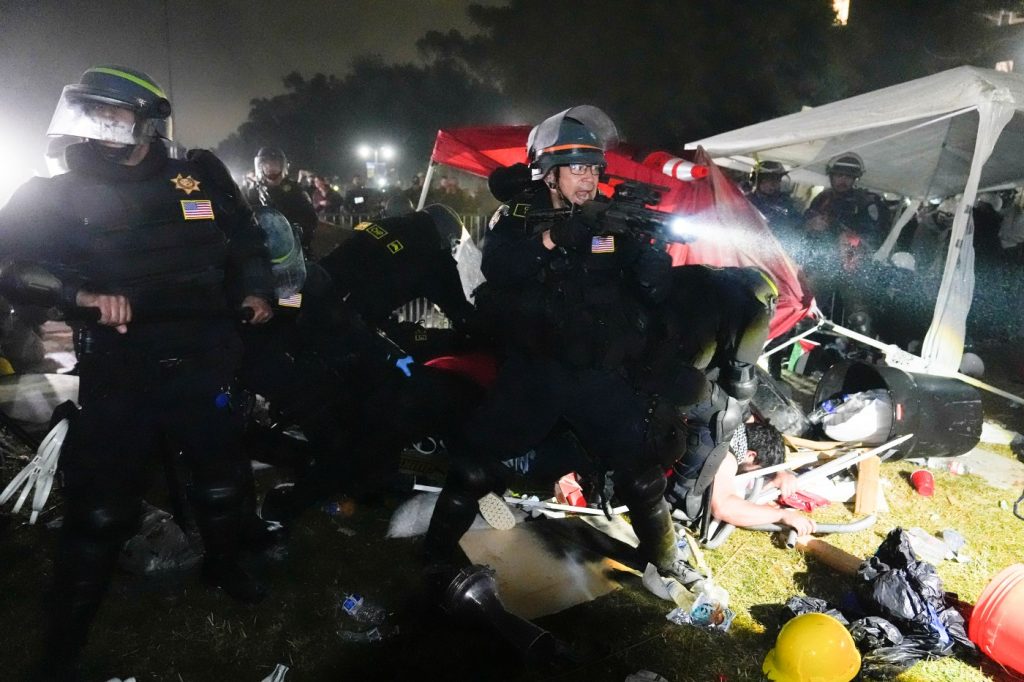The pro-Palestinian encampment at UCLA last week became the latest campus tinderbox to erupt. As the police response unfurled before our eyes, I watched, not as a layman, but from the perspective of someone who has worn the boots that stand between calm and chaos.
I retired as a lieutenant after 30 years with the Los Angeles Police Department and oversaw the officers that dispersed protestors and extracted lawbreakers from hostile crowds during the 2000 Democratic National Convention in Los Angeles. I have seen instances of legitimate police brutality and excessive force in the handling of demonstrations, and I have also had a hand in combating it.
In 2007, the LAPD faced criticism for its response to a May Day immigration demonstration in MacArthur Park. Officers were seen on video indiscriminately firing rubber bullets into a crowd that included many peaceful protestors and journalists, resulting in numerous lawsuits.
Criticism of these types of police responses has revolved around issues of excessive force and lack of accountability — most recently during the George Floyd protests — which prompted California to enact Assembly Bill 48, a 2021 law that restricts the types of force cops can use when responding to protests.
In short, the use of rubber bullets, bean bag shotgun rounds and tear gas are largely prohibited, except when specific requirements are met. So I was rather shocked to see an officer fire a single bean bag shotgun round into the crowd, pause, then fire another three rounds in rapid succession.
Bean bag rounds are meant for single-target acquisition. They should only be used on an individual engaged in a violent act — not aimed indiscriminately into a crowd.
Admittingly, I do not know what the officer articulated as the rationale for his actions, but I have trouble reconciling the lack of evidence of any threat to life or serious bodily injury to anyone. And if there was, where was the effort to arrest someone, making this application of force permissible under the new law?
These types of actions can dominate the media coverage and public discourse, diverting away from the reality that, on this day, law enforcement overall carried out a measured plan that prioritized the rights of everyone involved.
The fact is that a lot of cops are not especially adept at dealing with emotionally charged crowds. When these situations do arise, they are met with a sense of uneasiness, often due to a lack of knowledge of the laws that govern their actions, and being oblivious to how their actions influence the trajectory of the situation.
Policing demonstrations demands decision-making with a special intensity. In any given situation, officers make numerous decisions over the course of an incident. Some of them are intentionally measured and some of them are split-second responses, but all of them need to be made with the knowledge that their “rightness” or “wrongness” may influence the public’s overall perception of the event.
Related Articles
Richmond adopts Israel divestment policy
Congressional panel grills Berkeley schools chief
Goldberg: Senators need to stop the Anti-Semitism Awareness Act
Police in Berlin break up pro-Palestinian student protest
Protesters breach barricades, re-occupy MIT encampment
Eventually, we will all know if the legislation caused impactful change in police culture. Law enforcement agencies are required to publish an incident report within 60 days on their website that gives justification for the use of any “kinetic energy projectiles” (such as bean bag rounds or rubber bullets).
Despite historically disguising deficiencies with simplistic excuses or complicated explanations, neither of which are productive, many in law enforcement recognize the need for cultural change to address issues of excessive force and accountability.
Properly addressing inappropriate actions will go a long way in building public trust that has been lost through the mistakes of the past. Acknowledging inappropriate applications of force help demonstrate the ways officers can become more skilled at executing deliberate, intentional actions in accordance with the law — but more importantly, consistent with societal expectations that are better for us all.
Jeff Wenninger retired as a lieutenant after 30 years with the Los Angeles Police Department. He helped investigate and adjudicate more than 700 deadly force police incidents. He wrote this column for CalMatters.


